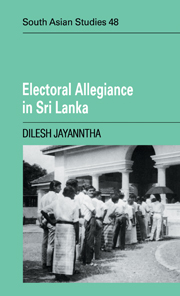Book contents
- Frontmatter
- Contents
- Acknowledgments
- List of abbreviations
- 1 Introduction
- 2 Bluville: the constituency and the patronage network of Doctor Ay (1947–1959)
- 3 Bluville: the patronage network of Korale-Mudaliyar Kit Foo and his son, Dee (1947–1959)
- 4 Bluville: the growth of the State (1956–1982)
- 5 Greenville: the patronage networks of the Mou/Nous and the Pou/Kous (1947–1959)
- 6 Greenville: the growth of the State (1956–1982)
- 7 Red Town: the urban setting (1947–1959)
- 8 Red Town: the growth of the State (1956–1982)
- 9 Communal minorities, political dissidents and the JVP
- 10 Conclusion
- Glossary of Sinhalese Terms
- References
- Index
- CAMBRIDGE SOUTH ASIAN STUDIES
7 - Red Town: the urban setting (1947–1959)
Published online by Cambridge University Press: 11 September 2009
- Frontmatter
- Contents
- Acknowledgments
- List of abbreviations
- 1 Introduction
- 2 Bluville: the constituency and the patronage network of Doctor Ay (1947–1959)
- 3 Bluville: the patronage network of Korale-Mudaliyar Kit Foo and his son, Dee (1947–1959)
- 4 Bluville: the growth of the State (1956–1982)
- 5 Greenville: the patronage networks of the Mou/Nous and the Pou/Kous (1947–1959)
- 6 Greenville: the growth of the State (1956–1982)
- 7 Red Town: the urban setting (1947–1959)
- 8 Red Town: the growth of the State (1956–1982)
- 9 Communal minorities, political dissidents and the JVP
- 10 Conclusion
- Glossary of Sinhalese Terms
- References
- Index
- CAMBRIDGE SOUTH ASIAN STUDIES
Summary
Introduction
Red Town, an urban constituency, lies on the outskirts of Colombo. In 1946 the electorate covered an area of approximately fifty-five square miles stretching from two highly urbanized and rapidly industrializing peruwas in the west to a less urban peruwa in the east, and three much more rural and agrarian peruwas in the north-east. Thus, under the first delimitation (1946–59), just over a third of the electorate's population fell within a highly urbanized frame of reference and about a half within a largely agrarian setting.
Unlike the Bluville and Greenville electorates of this time, in both of which Buddhists represented over 90 per cent of the electoral strength, and no other religious community accounted for over 5 per cent of the total, in Red Town, the Christians formed a numerically important minority. In 1946 they accounted for about one sixth of the electorate's population. They were concentrated in the more urbanized western part of the electorate. The majority were Sinhalese, and a large proportion hailed from non-Goigama castes, particularly the Vahumpura.
With regard to caste, in the electorate as a whole, about 50 per cent of the constituents would have been Goigama at this time, about 25 per cent Batgam, and about 20 per cent Vahumpura, the remainder being from other minor communities. The Goigama were spread fairly evenly throughout the electorate. Most of the Batgam and about half the Vahumpura were concentrated in the agricultural eastern part of the electorate. Here, they were bound to the Goigama village elite by ties of obligations and dependence, very similar to those operating in Greenville.
- Type
- Chapter
- Information
- Electoral Allegiance in Sri Lanka , pp. 137 - 156Publisher: Cambridge University PressPrint publication year: 1992



